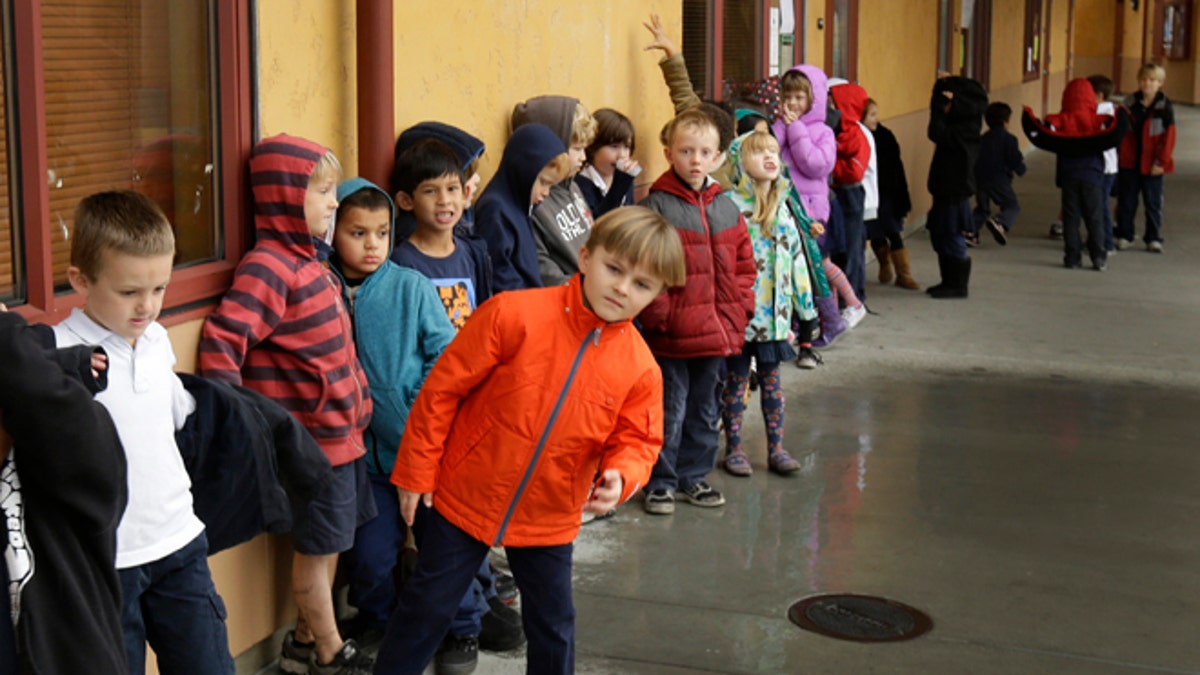
Jan. 24, 2013: A first grade class of 30 children waits to enter a classroom at the Willow Glenn Elementary School in San Jose, Calif. (AP)
In the free market, companies that don’t satisfy their customers needs don’t survive. A new, better company will come along and fix any problems. Unfortunately, the same doesn’t hold true when the customers are families and the company is the public education system. As a mother and a former eighth grade U.S. history teacher, I have seen the unions and special interests play to parents’ fear about school choice, but the fact remains that competition and options are long overdue in our education system.
Unions utilize tactics of fear to convince teachers and school administrators that school choice will ruin the teaching profession. They mobilize teachers, parents and other stakeholders against school choice on these false premises. One of the most glaring examples of union influence occurred last fall in Louisiana, where the Louisiana Association of Educators sued the state to prevent implementation of a new voucher system that expanded the state’s current slate of school choice options.
Unions influence teachers, administrators, and school board members on all levels of policy. Without providing proof of their claims, the National Educators Association has a section on its website devoted to opposing vouchers, stating "the NEA opposes vouchers because they divert essential resources from public schools to private and religious institutions," and later that they "oppose alternatives that divert attention, energy, and resources from efforts to reduce class size, enhance teacher quality, and provide every student with books, computers, and safe and orderly schools." None of these claims are supported, yet teachers and other members are inundated with this message.
[pullquote]
The teachers unions have extended their tactics beyond issues pertaining solely to education. They also attempt to use their forces and influence to argue against other union-targeted legislation. For example the Michigan Education Association asked its teachers to abandon their students in the classroom (26,000 of them) in order to attend a protest against Gov. Snyder's Right to Work legislation.
The result of this system, which is protected with monopoly-like status by the government, is that 48 percent of our public schools are failing and more than one million students drop out each year before earning a diploma. How do we reject the status quo, led by a federal bureaucracy, and seek a return to local control? School choice is the answer.
As a mother, I want my son to have a passion for learning. I want him to question, to discover, to get lost in the adventure of books, to think critically and resolve problems with creative solutions. I want a school environment for him that welcomes debating history from multiple perspectives and imagining the impossible. I want teachers who foster this sense of innovation, and encourage students to take risks because after failure comes sweet success.
Dumping more money into an educational system that is fundamentally broken is not the answer. Public school systems are spending more than ever but getting few if any results, in large part because the increased funding isn't making its way to the classroom. Instead, it's being spent on bureaucracy and bloated administrative offices.
Since 1950, the American student population has increased by 96 percent. In the same time period, administrative and non-teaching positions have exploded by 702 percent (and climbing) while teaching positions have increased 252 percent. (U.S. Department of Education, National Center for Education Statistics, 1991 Digest of Education Statistics, Tables 37 and 77; 2010 Digest of Education Statistics, Tables 36 and 87)
These increases account for more than $23 billion dollars that could be spent annually in classrooms, instead wasted on ineffective programming. It’s time to return control of the education dollar back to the family, where it originates.
School choice is the right choice for parents and children in struggling communities with low performing schools and limited access to alternatives. With a widening achievement gap, charter schools have provided a viable alternative. In Washington, D.C., where the educational system has historically struggled, students attending charter schools graduate at a 30% higher rate than their public school counterparts.
School choice provides an opportunity for public schools to compete and improve - and for high-performing teachers to be recruited by top schools. More choice and competition in the educational marketplace fuels improvement and innovation across the board for students, teachers, and individual school districts.
I challenge parents, teachers, and activists around the country to come together in support of school choice. Get involved with National School Choice Week. Start attending school board meetings, run for open seats, and challenge your administrators where you see waste. Find out what options are available in your state and seek to attain or expand them. Work with state legislators to pass school choice legislation that best fits your community.
Remember that every victory, however small, is a step on the path to education freedom. Returning control of education dollars to parents and local communities gives parents (and ultimately the student) the power to shape their own family’s future. Together, we can work to create a system where schools compete for top teachers, the achievement gap disappears, and all children -- no matter their economic situations-- have access to a quality public education.
